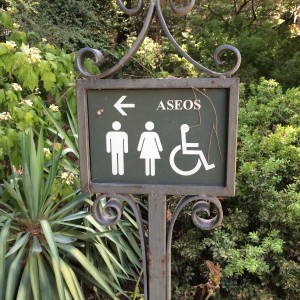Global communication through the visual
“… the most important skill students need to learn is to negotiate regional, ethnic, or class based dialects; variations that occur according to social context.” (New London Group, 1996, P. 8)
I have been reflecting upon the representation of symbols on signs lately, since an article by Ty Burr was published in the Boston Globe on July 2, 2015 entitled Do You Speak Canadian Sign? The author had traveled through New Brunswick and was intrigued with the random signs with graphic symbols used to represent various roadside items and pondered over the interpretation of their meaning. The author had some interesting suggestions for the meanings of these regional signs.
For many of us, reacting to the symbolic shapes on signs is done without consciously thinking about it. For instance responding to the drawing of a gasoline pump, or the plate and utensils that we pass on road signs throughout the country. Many of these signs have become universal and we rely heavily on them, when we do not speak the language.
While traveling in Spain I came across a sign saying WC with an arrow. Knowing that my French speaking family refers to the vecee (short for “water closet” which is a British term) and noting the direction of the arrow I was able to contextually interpret the location to the washroom. The following sign however, even though written in Spanish was much more helpful.
“Humans are at this level contextual and sociocultural “pattern recognizers” and actors. Such pattern recognition underlies the ability to act flexibly and adaptable in context- that is, mastery in practice.” (New London Group, 1996, P. 20)
What does this mean in the global context? We are recognizing the need to develop literacy symbols that enable us to communicate globally, regardless of which language we speak. The historical background for international symbols began with the “Vienna Method” designed by a sociologist and philosopher named Otto Neurath, in 1920. According to Lewis 2006, the symbols were used to “represent statistical graphics in ….an organized attempt to use graphical design for the purpose of achieving changes in society, primarily through visual education of the masses, and especially by presenting basic socio-economic facts in a readily comprehensible form.” (p. 8). Graphic images were introduced to represent specific sports in the 1964 Tokyo Olympics, and free universal travel icons (Bathroom, gas, etc.) were made available in 1974 by the American Institute of Graphic Arts. Currently, the IS0 (International Organization for Standardization) manages the distribution of these symbols and in some cases the regulation of these universal symbols is now becoming a concern. The symbols are no longer free, and have ISO regulations.
According to Lammie (2012), companies hoping to avoid the expense and paperwork of accessing these symbols are now creating their own. Returning to my examples of travel in Spain, the icons on an iPhone are all the same. The language underneath the icon is somewhat different, although many English words, arguably the language of the world, remain on the Spanish phones.
Will we learn to reply more on the symbolism within society so that we can communicate universally, and across linguistic systems? Will this be regulated by organizations such as ISO, or will our large technology companies such as Apple begin to dictate their symbolism as their product is distributed globally? Perhaps through these experiences with universal signs, we will learn to interpret the local “Canadian” signs, as we would learn expressions within a specific spoken dialect.
References:
Lammie, R. (2012) Everywhere a Sign: A Brief History of International Symbols http://mentalfloss.com/article/30552/everywhere-sign-brief-history-international-symbols
Lewis P. J. (2006) Speaking of Graphics, Chapter 6: Neurath and the Vienna Method of Picture Statistics. Retrieved from: www.datascope.be/sog/SOG-Chapter6.pdf
The New London Group (1996) A Pedagogy of Multiliteracies: Designing Social Futures. Harvard Educational Review, (66, 1)1-29.
Tyre, P. (2015) Do you speak Canadian Sign? Retrieved from: https://www.bostonglobe.com/arts/2015/07/02/tycolumn/…/story.html




I read that article as well and I found myself emailing the author with a photo I had taken of a ridiculous sign in Kenora, ON that shows a child injured on the ground. I guess the message was watch for children but it seemed to be saying watch for dead children.
I also was reminded of a sign I saw in a bathroom in Australia. It was very similar to this one found here: http://ideas.health.vic.gov.au/resources/images/hygiene-male-toilet.gif . After the squat experiences I had in Kenya, I wish there had been a sign with some instruction! It certainly is, as you say, important to be able to understand visuals as they can be universal!